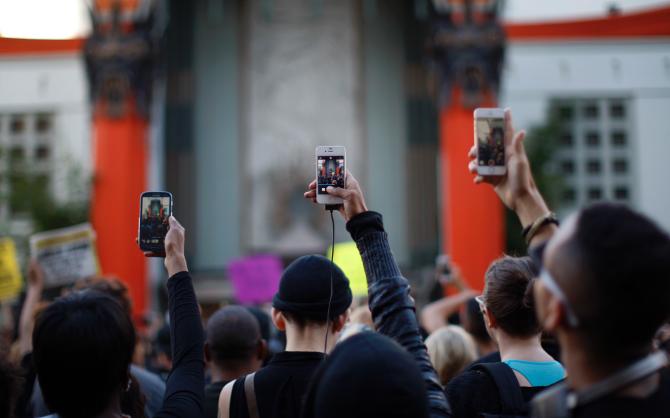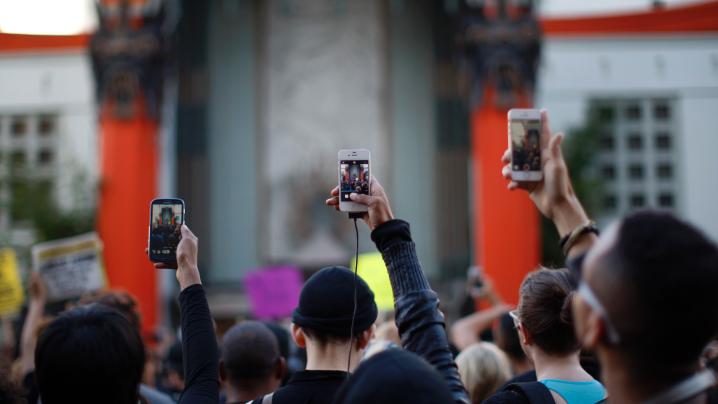[ad_1]

People aim cellphones at a speaker in front of the TCL Chinese Theatre on Hollywood Boulevard in Los Angeles on Dec. 6, 2014, as they march to protest the decision in New York not to indict a police officer involved in the choke hold death of Eric Garner in New York City.
David McNew/Getty Images
Those advocating for a freer and more just America have always used the latest communications technology to further their aims. In 1841, abolitionist Frederick Douglass launched the North Star newspaper using the advanced communications technology of the 19th century, the printing press, to fight for the freedom of black people. Douglass and the suffragists of the late 19th and early 20th centuries followed in the tradition of the great pamphleteers, such as Thomas Paine, who built support among fellow colonists to separate themselves from the king of England.
President Franklin Delano Roosevelt used commercial radio to broadcast fireside chats to the American public about how he was trying to alleviate the impact of the Great Depression in the 1930s and ’40s.
In the 1950s and ’60s, Martin Luther King Jr. and other civil rights leaders knew that television cameras capturing the brutality of oppressive sheriffs would outrage Americans in their living rooms far from the front of segregation. The repulsion Americans felt when they saw women and children attacked by men wielding firehouses and dogs set in motion one of the great reform movements in American history.
Today, protest leaders across America capture moments of outrage with cellphone cameras and distribute videos over the Internet to worldwide audiences using social media.
Those who created the printing press, radio, television and mobile phone had no idea that their inventions would be used as tools in the fight for justice. Yet in each era, Americans used technology built to educate, entertain and enable business transactions in order to accomplish political goals.
These days, new social media platforms emerge regularly. Individuals have become broadcast channels with audiences rivaling some small radio stations. The barrier to new technologies reaching even wider audiences is lack of high-speed Internet access, and for many people who need it most, the barrier to access is cost. This Black History Month, reforming the federal Lifeline program to include broadband should be elevated as a key step to increasing access for Americans with the lowest incomes.
As the telephone became a tool necessary to conduct business, get access to emergency services and stay in touch with family and friends, Rep. Mickey Leland (D-Texas), then-chairman of the Congressional Black Caucus, prompted President Ronald Reagan’s Federal Communications Commission to create the Lifeline program in 1985 to lower costs and increase access to that critical service for low-income Americans. The Bush administration widened the program to include access to mobile phones. As the Internet becomes the standard required to access commercial services, apply for employment and complete homework, it’s time to include broadband service in the Lifeline program.
Along with adding broadband, policymakers should reform how the Lifeline program operates. Streamlining the application process by coordinating eligibility qualification with other federal programs and giving individual citizens the power to choose among providers on their own with a Lifeline Benefits Card should lower costs and gather more bipartisan support.
From reading pamphlets and newspapers to listening to the radio and watching television, American democracy has relied upon the communications technology of each era to engage citizens. Political candidates post digital video to communicate ideas, and activists are only becoming more creative in engaging followers online. Access to high-speed Internet service is critical for participating in the great American debates of today. Reforming Lifeline to include broadband service will help ensure that more Americans are able to bring more change.
The Root aims to foster and advance conversations about issues relevant to the black Diaspora by presenting a variety of opinions from all perspectives, whether or not those opinions are shared by our editorial staff.
Larry Irving was assistant secretary of commerce during the Clinton administration and is a founding co-chair of the Internet Innovation Alliance. Jamal Simmons is a top political analyst and a co-chair of the IIA.
[ad_2]





















